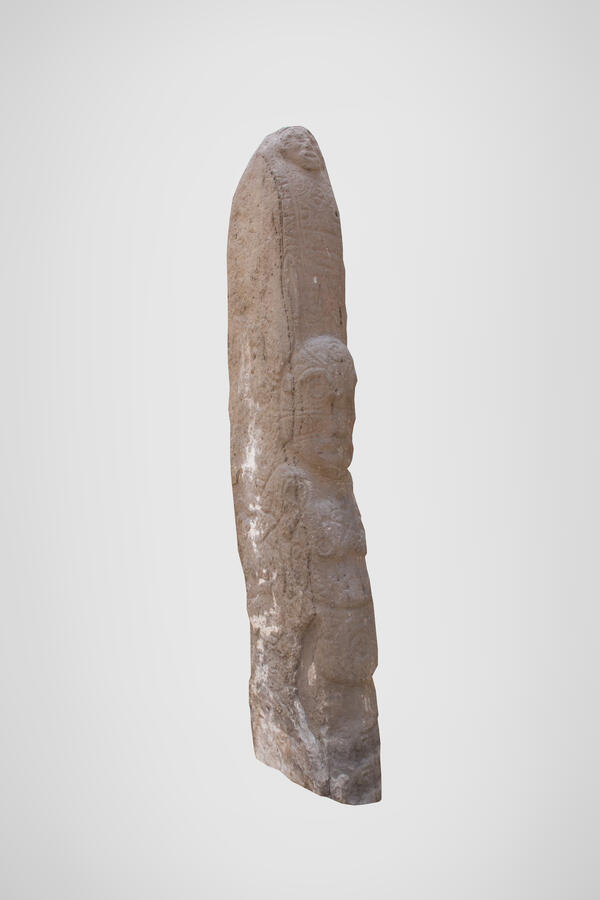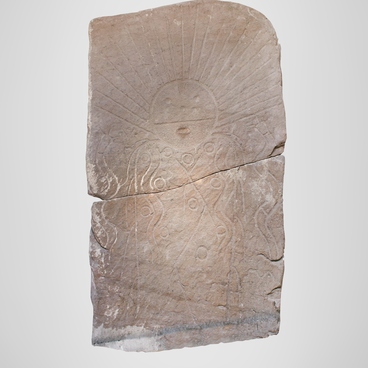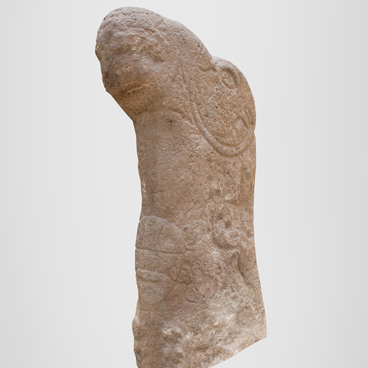The stone statue, decorated with images in the technique of pecking, was the corner stone of the fence of the Tagar mound, discovered at the Shira railway station during the construction of an elevator (granary). Archaeologist Albert Lipsky brought it to the Khakass Museum of Local History in 1955.
The statue is dated back to the Okunev archaeological culture — the South Siberian culture of nomadic cattle-breeders of the Bronze Age. That is, the monument was created in the period from the end of the 3rd to the beginning of the 2nd millennium BC.
The presented statue is one of the most compositionally complex ancient monuments known to science. In the center there is an anthropomorphic mask with animal horns and ears, which is divided into three parts by horizontal stripes. It symbolizes the ancient ideas of the Khakass about the three-part structure of the world. This worldview was characteristic of early religious beliefs.
In the upper part of the face, the third eye of the deity is depicted in the form of a solar sign — an ancient symbol of the universe. The other two eyes are carved in concentric circles with a dot inside.
In the upper part of the monument there is an image of a tall cone-shaped headdress with complex ritual drawings. Inside you can see a drawing of a predatory creature, presumably a dragon, with an open mouth, a forked tongue and sharp teeth. The beast “attacks” the solar sign, the third eye of the deity.
Under the mask, in the lower part of the statue, there is an image of a bear’s head with an open mouth and bared teeth. His ears, eyes and nose are clearly traced; a pattern in the form of an oblique cross is engraved on his forehead. Another solar sign is depicted under the head of the bear in the form of a circle with four symmetrically located corners on the sides and with four circles of smaller diameter in the center.
The mythological motif of a predator’s attack on a solar sign was often found in ancient legends: this is how people explained the sunset. The predator devoured it, and night fell.
Two more solar signs are depicted on the right side plane of the statue. The heads of predatory creatures are turned in profile there.
The statue is dated back to the Okunev archaeological culture — the South Siberian culture of nomadic cattle-breeders of the Bronze Age. That is, the monument was created in the period from the end of the 3rd to the beginning of the 2nd millennium BC.
The presented statue is one of the most compositionally complex ancient monuments known to science. In the center there is an anthropomorphic mask with animal horns and ears, which is divided into three parts by horizontal stripes. It symbolizes the ancient ideas of the Khakass about the three-part structure of the world. This worldview was characteristic of early religious beliefs.
In the upper part of the face, the third eye of the deity is depicted in the form of a solar sign — an ancient symbol of the universe. The other two eyes are carved in concentric circles with a dot inside.
In the upper part of the monument there is an image of a tall cone-shaped headdress with complex ritual drawings. Inside you can see a drawing of a predatory creature, presumably a dragon, with an open mouth, a forked tongue and sharp teeth. The beast “attacks” the solar sign, the third eye of the deity.
Under the mask, in the lower part of the statue, there is an image of a bear’s head with an open mouth and bared teeth. His ears, eyes and nose are clearly traced; a pattern in the form of an oblique cross is engraved on his forehead. Another solar sign is depicted under the head of the bear in the form of a circle with four symmetrically located corners on the sides and with four circles of smaller diameter in the center.
The mythological motif of a predator’s attack on a solar sign was often found in ancient legends: this is how people explained the sunset. The predator devoured it, and night fell.
Two more solar signs are depicted on the right side plane of the statue. The heads of predatory creatures are turned in profile there.



